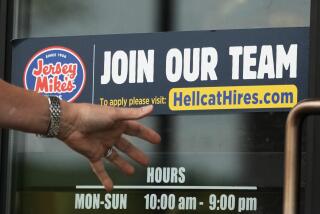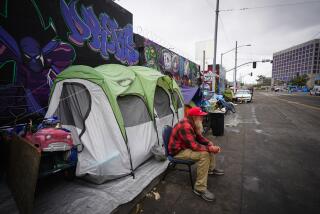Today is crucial for Democrats in California’s House race
Voters in California’s key House districts are poised Tuesday to determine match-ups that will be critical for Democrats’ chances of taking back the House this fall.
The most pressing concern for Democrats is whether their wide, boisterous field of candidates means the party will be locked out of multiple races thanks to the state’s top-two primary, which advances the two candidates with the most votes regardless of party.
The prospect of voters only having the choice between two Republicans on the ballot in crucial races in November has forced Democratic groups to spend more than $7 million in the closing weeks of the campaign to avert disaster here.
“Tuesday’s primaries in California are obviously taking all of our attention because of how big the stakes are,” said Meredith Kelly, a spokeswoman for the Democratic Congressional Campaign Committee.
Democrats have targeted 10 GOP-held seats here, including seven won by Democrat Hillary Clinton in the 2016 presidential election. California has as many potential pickup districts than the seven other states with primaries on Tuesday combined.
Live coverage of California primary »
The party is preparing for what it sees as the worst-case scenario: Democrats get shut out of one or two California races. That would leave them to compete in at least five GOP-held districts where Clinton won in 2016. Two of those districts in the Central Valley have proved hard for Democratic House candidates to penetrate. If they are shut out of more than a couple of districts in the primary, Democrats will have to scramble to focus on opportunities elsewhere in the country to flip the 23 seats they need to retake the House.
Democrats have expanded their map of targets around the nation in part due to an intense boom of enthusiasm they are seeing and the bumper crop of first-time candidates stepping up to run. But here, in the epicenter of the resistance, that enthusiasm could cost them.
Nowhere is that risk more acute than in Orange County, the former bastion of conservatism that is experiencing a demographic makeover and in 2016 voted for a Democrat for president for the first time in 80 years. Both the Democratic and Republican congressional race arms have set up offices in Orange County, an unprecedented move for the Washington-centric organizations.
In the 48th Congressional District, for example, eight Democrats, all of them first-time candidates, are on the ballot against GOP Rep. Dana Rohrabacher. His eroding support among local party activists and the addition of well-known Republican Scott Baugh to the fray has left Democrats most concerned about splitting the vote there.
State and national leaders divided their support between two top-polling candidates, with the California Democratic Party endorsing stem cell scientist Hans Keirstead and the DCCC behind real estate investor Harley Rouda.
Watch these House races in California’s June 5 primary »
As Tuesday’s vote neared, the DCCC handed out fliers in the district warning voters not to waste their votes on three other Democrats who dropped out but remain on the ballot. They also spent more than $1.6 million attacking Baugh and, in a twist, even dropped six figures to boost a little-known Republican.
They’ve employed similar tactics in the state’s two open seats, Rep. Ed Royce’s 39th District and Rep. Darrell Issa’s 49th District. Both Republicans have announced they’ll retire after this year. In the race to replace Royce, the DCCC backed lottery winner and Navy veteran Gil Cisneros, whose sparring with fellow Democrat Andy Thorburn became so caustic that it prompted California’s state party chair to broker a truce.
In Issa’s district, $2.3 million spent by pro-abortion rights group Emily’s List to support Democrat Sara Jacobs has complicated Democrats’ efforts to unite voters and winnow the field. So have the seemingly unlimited coffers of Jacobs and Paul Kerr, both multimillionaires who struggled in early polling but have blanketed the district with TV ads bashing President Trump and touting their biographies.
In both districts, Democrats face Republican candidates who are current or former elected officials with far more political experience and name recognition.
The national Democrats’ hyper-focus on their top-two primary problems has meant less attention paid to promoting female candidates in what’s shaping up to be a banner year for women in politics. It’s also meant party leaders have less bandwidth to fret over what kind of Democrat may make it through in these districts, and whether they’re best-positioned to seize swing districts where incumbents often still have major advantages.
For example, Katie Porter, a law professor locked in an acrimonious fight with fellow Democrat and law professor Dave Min, has aligned herself with Sen. Elizabeth Warren (D-Mass.) and other progressive elements of her party. If she wins, Democrats will have to rely on a surge in progressive turnout in November to defeat GOP Rep. Mimi Walters.
How California’s primary could stop Democrats from retaking the U.S. House »
As of Monday evening, early mail ballots cast by voters were running behind levels at the same point in 2014 in nearly all of the targeted races, according to numbers provided by Political Data Inc., an election data firm.
One exception was Issa’s district, where a tight-knit group of activists hosted weekly protests outside the congressman’s office and have spent months registering and talking to voters. There, about 70,600, or 27%, of permanent mail voters had turned in ballots as of Friday, up from 24% in 2014. Democrats and Republicans were running about even in mailed ballots, an anomaly in a state where GOP voters often over-perform in midterm years. That could still change, as Democrats tend to turn out in greater numbers on election day.
For the most part, though, Republicans in the state are on the defense. None of the Democrats being targeted by the Republicans have attracted challengers with serious fundraising.
Republican voter registration has cratered in the state, officially reaching third-party status below Democrats and nonaffiliated voters shortly before primary day.
Several of the GOP incumbents fending off serious challengers have had lackluster fundraising. Rohrabacher, Rep. Tom McClintock in Northern California, Rep. Duncan Hunter in inland San Diego County and Rep. Steve Knight in the Antelope Valley have all been out-raised by their opponents at various points in the election cycle. While they have been able to mostly keep their powder dry as Democrats battle each other for a shot at the general election, they will need to vastly improve their cash strategy to be competitive.
“The Democrats think there’s no stopping them this time,” Walters warned at the state GOP convention in May. “They’re not just coming for any one of us. They’re coming for all of us.”
But, she added, things won’t be quite so easy for them. She and others have pinned their hopes on an unpopular state gas tax, which will likely be the subject of a repeal effort on the November ballot, and an improving economy that national Republicans are hoping to tie to the recent tax cuts.
Recent polls that suggest Republican gubernatorial candidate John Cox could grab the second spot on the November ballot have also given GOP leaders hope that they’ll be able to turn out voters and stem the tide of Democratic enthusiasm this fall.
“Look at how nasty and divisive these primaries have gotten,” said National Republican Congressional Committee spokesman Jack Pandol of the Democrats. “I think it’s getting a little ahead of themselves to say that everything’s going to be kumbaya and everyone will just come together.”
Your guide to the June 5 primary »
For more on California politics, follow @cmaiduc.









